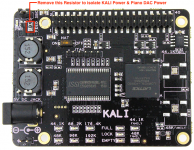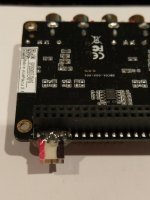Hi,
I have the kali installed on rpi3 togehter with mambo ls. The software is moode v. 3.8.2.
I have the following problem:
All sample rates are running perfectly except 16/48, 24/48, 24/96. There I get very loud noise.
I thought that the oscillator for 48 khz is brocken. But sample rate 24/192 is running OK.
When I play the same music without Kali. Everything is fine.
Did anyone experience the same problem?
Hi,
Are u using Adv kernel and bclk_ratio_int_div setting?
It turns out that this setting is no longer is valid in the .41 kernels and will be deprecated in upcoming moOde release 3.8.3
-Tim
Please make the Volt+ BTL available as board alone, (not already boxed with volume) for those who want to make their own multichannel amps... Thanks!
I second this idea
I second this idea
We will , with or without stepped attenuator. (PCB only)
Again , on this board we incorporated every trick and lesson we learned from the old Volt+
However , in the audio path everything is different. We have a lot of experience designing analog stages (look at our DACs) and we beefed up the analong on the Volt+ D. PPS capacitors in the analog path (smd) and film for LC filters etc.
Frankly only in hi end amplifiers were film capacitors used so extensively . Even power is decoupled using multiple film capacitors.
Our goal in designing was simple . The best sounding TPA31xx on the market...of course the tests must back up this claim.
However , by using ceramic in the analog path (instead of PPS) you will see only a small decrease in thd+n. However the sound will clearly be superior using those PPS (clearly thd+n is only part of the story) way more than numbers indicate.
I've had a trawl through this thread and looked at the Allo data sheet, but I can't see an easy way of getting an external power supply into the Piano. I'm guessing J19 for the Volt could be used to take isolated 5v in. Has anyone found a neat solution to block 5V through the 40 pin connector from the Pi or Kali below so isolated power can be used?
Just to let u know.
I recently ran into some issues while experimenting with a RPI/Piano21 bluetooth setup for my car.
It's been related to Piano21 - volume control.
Just saw a post over at Moode that might be related.
During the last couple of days we were hunting down some init issues
for the dual-modes.
Allo sent me two patched driver versions for testing.
So far everything looks good to me. No more weird stuff happening since two days.
We'll probably see the correction popping up in kernel 4.9.47.
It'll take some more time to get it into Moode and the rest of the bunch.
Keep the fingers crossed that Allo will run more thoroughly tests next time. They shouldn't rely on DIY-Audio hackers to run product tests.
Enjoy.
I recently ran into some issues while experimenting with a RPI/Piano21 bluetooth setup for my car.
It's been related to Piano21 - volume control.
Just saw a post over at Moode that might be related.
During the last couple of days we were hunting down some init issues
for the dual-modes.
Allo sent me two patched driver versions for testing.
So far everything looks good to me. No more weird stuff happening since two days.
We'll probably see the correction popping up in kernel 4.9.47.
It'll take some more time to get it into Moode and the rest of the bunch.
Keep the fingers crossed that Allo will run more thoroughly tests next time. They shouldn't rely on DIY-Audio hackers to run product tests.
Enjoy.
I've had a trawl through this thread and looked at the Allo data sheet, but I can't see an easy way of getting an external power supply into the Piano. I'm guessing J19 for the Volt could be used to take isolated 5v in. Has anyone found a neat solution to block 5V through the 40 pin connector from the Pi or Kali below so isolated power can be used?
Simon,
Sorry, I just saw your post. I checked with Allo on this awhile back and they didn't give me an easy way (not to say there isn't one) to separate the the Piano's power from the feeding board. BUT since I was using it on a Kali, they did suggest that I remove a 0R resistor there and the Kali would not be feeding the 5V to the Piano.
I did that and then fed the Piano via the GPIO 5V/Grnd pins.
If you are interested, I can dig that information up.
BTW, that was a significant improvement, though it still sounds very good being fed power from the Kali. I haven't recently tried it direct on an RPi, I was not too impressed with it that way. BUT on a Kali and especially with one of the isolators, it is very good!
Greg in Mississippi
@Greg
Do you have a pic showing the location of said 0R resistor on Kali please?
John
Attached is the diagram I got from Allo.
Once you remove that resistor on the Kali, it does not pass 5V up to the next board.
For the Piano 2.1, you can most easily use the 5V & Ground header pins.
I used the 5V & Ground pins on the expansion header down to the Kali (2nd picture).
I hope this helps!
Greg in Mississippi
P.S. I have found the people at Allo to be amazingly helpful and accommodating. I'm not saying this to dis anyone, but just to acknowledge them!
Attachments
Last edited:
Regarding power handling.
I gave that feedback long time ago.
Allo does it different on every board. Different structure, different plugs jacks
different spots. That's pretty annoying.
That doesn't make sense in a HAT environment, where boards get stacked.
I hope that one day they are listening to put the same type of jacks at the same spot - the right spot! And then stop making things so complicated
to attach and detach boards from common/joint to standalone power supplies.
And not to forget. Boards that run on other then 5V IMO will I'm pretty about that not gonna be a market success. That'll make things even more complex.
Enjoy.
I gave that feedback long time ago.
Allo does it different on every board. Different structure, different plugs jacks
different spots. That's pretty annoying.
That doesn't make sense in a HAT environment, where boards get stacked.
I hope that one day they are listening to put the same type of jacks at the same spot - the right spot! And then stop making things so complicated
to attach and detach boards from common/joint to standalone power supplies.
And not to forget. Boards that run on other then 5V IMO will I'm pretty about that not gonna be a market success. That'll make things even more complex.
Enjoy.
Kali 2. Please be patient. 1 of September I will give a full update. Hopefully I will have more than just words..(maybe, just maybe some test data)
We are finalizing PCBs on our midfi DAC (ess sabre 9028) and first finished product (Full Digital Amplifier)
Last thing on Kali 2 until September. We will use best clocks on it .
@cdsgames
Waiting for your report on Kali 2. Best clocks are wellcome! While best is arguable, what excellent clocks are you using?
I have baught ian's FIFO and KALI 1. ian's board is much better than KALI 1 according to my actual comparison. I hope that KALI 2 can significantly exceed KALI 1. it is best to provide a IC socket for allowing users to replace their own clock.
In addition, KALI 1 seems jitter too much, resulting in the replacement of a much better clock, it can not get a better sound, once again I hope that KALI 2 can significantly exceed KALI 1.
In addition, KALI 1 seems jitter too much, resulting in the replacement of a much better clock, it can not get a better sound, once again I hope that KALI 2 can significantly exceed KALI 1.
I hope this helps!
It helps the sound too! I agree that it makes an improvement.
John
Attached is the diagram I got from Allo.
Once you remove that resistor on the Kali, it does not pass 5V up to the next board.
For the Piano 2.1, you can most easily use the 5V & Ground header pins.
I used the 5V & Ground pins on the expansion header down to the Kali (2nd picture).
I hope this helps!
Greg in Mississippi
P.S. I have found the people at Allo to be amazingly helpful and accommodating. I'm not saying this to dis anyone, but just to acknowledge them!
Thank you Greg! ....and Allo
@cdsgames
Waiting for your report on Kali 2. Best clocks are wellcome! While best is arguable, what excellent clocks are you using?
+1
- Home
- Vendor's Bazaar
- New FIFO buffer for RPI/SBCs

